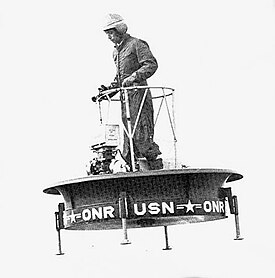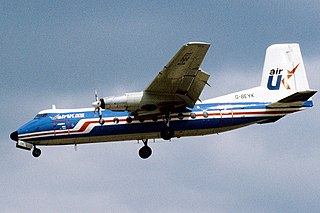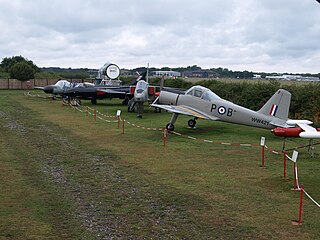
The Gloster Meteor is a fighter aircraft that was the first British jet fighter and the Allies' only jet aircraft to achieve combat operations during World War II. The Meteor's development was heavily reliant on its ground-breaking turbojet engines, pioneered by Frank Whittle and his company, Power Jets Ltd. Development of the aircraft began in 1940, although work on the engines had been under way since 1936. The Meteor first flew in 1943 and commenced operations on 27 July 1944 with No. 616 Squadron RAF. The Meteor was not a sophisticated aircraft in its aerodynamics, but proved to be a successful combat fighter. Gloster's 1946 civil Meteor F.4 demonstrator G-AIDC was the first civilian-registered jet aircraft in the world. Several major variants of the Meteor incorporated technological advances during the 1940s and 1950s. Thousands of Meteors were built to fly with the RAF and other air forces and remained in use for several decades.

The Ilyushin Il-18 is a large turboprop airliner that first flew in 1957 and became one of the best known and most durable Soviet aircraft of its era. The Il-18 was one of the world's principal airliners for several decades and was widely exported. Due to the aircraft's airframe durability, many examples achieved over 45,000 flight hours and the type remains operational in both military and civilian capacities. The Il-18's successor was the long range Il-62 jet airliner.

The Vickers Viscount is a British medium-range turboprop airliner first flown in 1948 by Vickers-Armstrongs. A design requirement from the Brabazon Committee, it entered service in 1953 and was the first turboprop-powered airliner.

The Heinkel He 280 was the first turbojet-powered fighter aircraft in the world. It was inspired by Ernst Heinkel's emphasis on research into high-speed flight and built on the company's experience with the He 178 jet prototype. A combination of technical and political factors led to it being passed over in favor of the Messerschmitt Me 262. Only nine were built and none reached operational status.

The Grumman F9F Panther is one of the United States Navy's first successful carrier-based jet fighters, as well as Grumman’s first jet fighter. A single-engined, straight-winged day fighter, it was armed with four 20 mm (0.79 in) cannons and could carry a wide assortment of air-to-ground munitions.

The British Aerospace 125 is a twinjet mid-size business jet. Originally developed by de Havilland and initially designated as the DH.125 Jet Dragon, it entered production as the Hawker Siddeley HS.125, which was the designation used until 1977. Later on, more recent variants of the type were marketed as the Hawker 800.

The de Havilland DH.110 Sea Vixen is a British twin-engine, twin boom-tailed, two-seat, carrier-based fleet air-defence fighter flown by the Royal Navy's Fleet Air Arm during the 1950s through to the early 1970s. The Sea Vixen was designed by the de Havilland Aircraft Company during the late 1940s at its Hatfield aircraft factory in Hertfordshire, developed from the company's earlier first generation jet fighters. It was later called the Hawker Siddeley Sea Vixen after de Havilland was absorbed by the Hawker Siddeley Corporation in 1960.

The Hawker Sea Hawk is a British single-seat jet day fighter formerly of the Fleet Air Arm (FAA), the air branch of the Royal Navy (RN), built by Hawker Aircraft and its sister company, Armstrong Whitworth Aircraft. Although its design originated from earlier Hawker piston-engined fighters, the Sea Hawk became the company's first jet aircraft.

The Antonov An-71 was a Soviet AWACS aircraft intended for use with VVS-FA forces of the Soviet Air Force, developed from the An-72 transport. Only three prototypes were built before the program was cancelled.

The Scottish Aviation Twin Pioneer was a British STOL transport aircraft built by Scottish Aviation Limited at Prestwick Airport, Scotland, during the 1950s. It was designed for both civil and military operators. It was conceived as a twin-engined version of the Pioneer light transport. Both aircraft required "an area only 30m (99ft) by 275m (902ft) in which to operate."

The Lockheed JetStar is a business jet produced from the early 1960s to the 1970s. The JetStar was the first dedicated business jet to enter service, as well as the only such airplane built by Lockheed. It was also one of the largest aircraft in the class for many years, seating ten plus two crew. It is distinguishable from other small jets by its four engines, mounted on the rear of the fuselage, and the "slipper"-style fuel tanks fixed to the wings.

The Hiller VZ-1 Pawnee was a unique direct-lift rotor aircraft, using contra-rotating ducted fans for lift inside a platform upon which the single pilot shifted body weight for directional control. The platform was developed starting in 1953 under an Office of Naval Research (ONR) contract to Hiller Aircraft, and flew successfully beginning in 1955.

The Handley Page Dart Herald is a 1950s British turboprop passenger aircraft.

The Conroy Skymonster (CL-44-0) is a 1960s United States specialized cargo aircraft based on the Canadair CL-44 freighter, with an outsize fuselage.

The Cirrus VK-30 is a single-engine pusher-propeller homebuilt aircraft originally sold as a kit by Cirrus Design, and was the company's first model, introduced in 1987.

The Avro Type 688 Tudor was a British piston-engined airliner based on Avro's four-engine Lincoln bomber, itself a descendant of the famous Lancaster heavy bomber, and was Britain's first pressurised airliner. Customers saw the aircraft as little more than a pressurised DC-4, and few orders were forthcoming, important customers preferring to buy US aircraft. The tailwheel undercarriage layout was also dated and a disadvantage.

The de Havilland DH.60 Moth is a 1920s British two-seat touring and training aircraft that was developed into a series of aircraft by the de Havilland Aircraft Company.

The Williams V-Jet II was designed and built by Burt Rutan's Scaled Composites for Williams International as a test bed and demonstrator aircraft for Williams' new FJX-1 turbofan engine.

The Doman LZ-5 was a utility helicopter developed in the United States in the early 1950s by Doman Helicopters Inc. of Danbury, Connecticut. Despite the procurement of international manufacturing agreements, no series production of the aircraft ever occurred, and only three prototypes were built. Two of these were purchased by the United States Army as the YH-31, but eventually becoming VH-31.

The Bournemouth Aviation Museum is an aviation museum located next to Bournemouth International Airport, near the village of Hurn in Christchurch. It houses a number of aircraft, aero engines, cockpits and a limited number of ground vehicles.





















